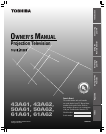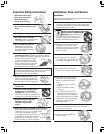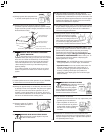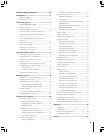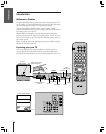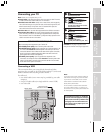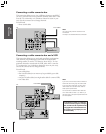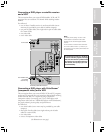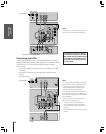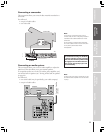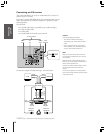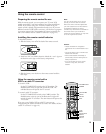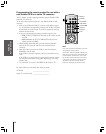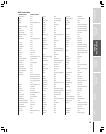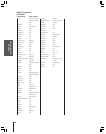
Introduction
Connecting
your TV
Using the
Remote Control
Setting up
your TV
Using the TV’s
Features
Appendix
Index
9
Connecting a DVD player or satellite receiver
and a VCR
This connection allows you to watch DVD/satellite, VCR, and TV
programs. You can record one TV channel while watching another
channel.
You will need:
• two (or three, if satellite receiver is used) coaxial cables (one or
more may be provided by your cable or satellite company)
• two pairs of audio cables (one single and one pair of audio cables
for a mono VCR)
• one video cable
• one S-video cable
ANT
(
75
)
ANT-1
CHANNEL IN
ON OFF
OUT
RL
OUT
VIDEO
VAR
AUDIO
L/
MONO
IN
DVD IN
L
R
P
R
P
B
Y
L/
MONO
AUDIO
R
S-VIDEO
VIDEO
OUT
ANT-2
AUDIO CENTER
VIDEO 1 VIDEO 2
COLOR
STREAM
INPUT
AUDIO
R
AUDIO
IN from ANT
VIDEO AUDIO
OUT to TV
CH 3
LR
CH 4
IN
OUT
IN from ANT
VIDEO
OUTOUT
S-VIDEO
AUDIO
OUT
L
R
Connecting a DVD player with ColorStream
®
(component video) and a VCR
This connection allows you to watch DVD, VCR, and TV programs,
and record TV programs. You can record one channel while watching
another channel. Your TV is capable of using ColorStream
(component video). Connecting your TV to a DVD player with
component video (such as a Toshiba DVD player with ColorStream),
can greatly enhance picture quality and performance.
You will need:
• two coaxial cables (one or more may be provided by your cable
company)
• three pairs of audio cables (two single and one pair of audio
cables for a mono VCR)
• two video cables
• one set of component video cables
(See illustration on next page)
Note:
For better picture quality, use an S-video
cable instead of a standard video cable
between the TV and DVD player/satellite
receiver.
Do not connect a standard video cable and
an S-video cable to Video-1 (or Video-2) at
the same time or the picture performance will
be unacceptable.
TV
From Cable
Stereo VCR
From Satellite dish
(for satellite
receiver only)
DVD Player/Satellite Receiver
The unauthorized recording, use, distribution,
or revision of television programs, videotapes,
DVDs, and other materials is prohibited under
the Copyright Laws of the United States and
other countries, and may subject you to civil
and criminal liability.



